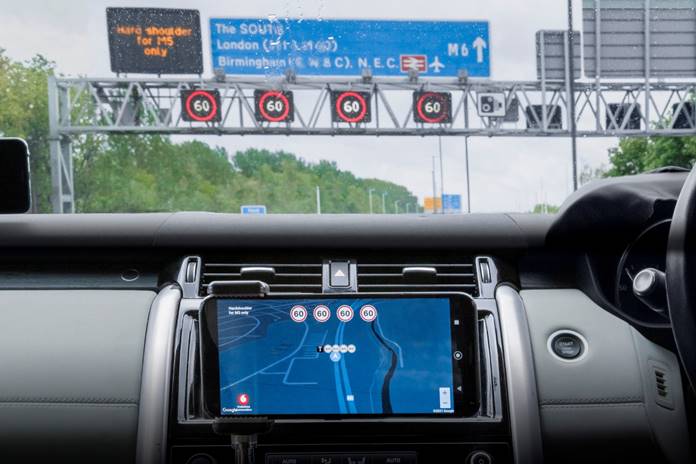Transport for West Midlands (TfWM), responsible for transport services in the West Midlands region in England, is working with Vodafone and Nokia to offer a new cloud platform that uses 5G-based vehicle-to-everything (V2X) technology to connect road users in with live updates from Highways England about local lane closures, speed restrictions, and traffic incidents.
It is the first live implementation of cellular V2X (C-V2X) technology in the UK. The project uses Vodafone’s 4G and 5G networks in the West Midlands region, alongside its multi-access edge computing (MEC) deployments. As it stands, the platform is available via smartphones to road users in the region’s city centres and key transport hubs, including Birmingham, Coventry, and Wolverhampton.
Vodafone said it is working with private and public sector organisations to integrate the platform into in-vehicle connected ‘infotainment’ systems. Nokia is providing analytics software for the project. London-based data sharing provider Chordant, owned by InterDigital, is providing its mobility data exchange facility Convex into the bargain, enabling road operators to share data with traffic systems.
Road authorities are also trialling the platform to control and ease traffic jams and make informed planning decisions using secure, anonymised and aggregated vehicle position data sent up to 10 times every second from users who have opted into the service.
Vodafone said emergency services may also use the facility, in order to respond to certain road incidents – “such as someone driving the wrong way on a motorway, or for breakdown recovery organisations to assist vulnerable road users”. It said the platform will “ultimately connect vehicles, cyclists, pedestrians, and infrastructure in a seamless digital transport ecosystem”. It wants to establish the platform for road users “across Europe and Africa”.
The project has support from the UK Government Centre for Connected and Automated Vehicles (CCAV) and the Midlands Future Mobility (MFM) consortium. It is part of the UK’s CAM (Connected and Automated Mobility) Testbed facilities, which cover a network of sites in Bedfordshire (Millbrook-Culham), Coventry (ConVEx and Midlands Future Mobility), Warwickshire (HORIBA MIRA), Leicestershire (CAVWAY), and London (Smart Mobility Living Lab).
Mike Waters, director of policy, strategy and innovation at TfWM, said: “We are reaching the point where connected vehicle technology is able to start making a meaningful difference to the big issues in transport like safety and energy efficiency. The work we have done with Convex and Vodafone is moving solutions forward not just for the West Midlands, but for the whole country and really exemplifies the UK’s position of global excellence in this space.”
Luke Ibbetson, head of group R&D at Vodafone, commented: “It’s fantastic to see V2X mobile technology being deployed on the open road for the first time in the UK. While the system is delivered via smartphone, drivers will need to use handsfree equipment. Meanwhile we are working with the automotive industry and road operators to have the technology integrated within vehicles and transport infrastructure to make our roads safer.”
Chris Johnson, head of Nokia’s global enterprise business, said: “Safety is of paramount importance to the development of systems that connect road users across mobile platforms. Running on Vodafone’s edge, Nokia analytics software will apply data insights to make roads safer, provide a better experience for users, and enhance road infrastructure management efficiency in a way that can easily be deployed across multiple geographies.”
Ash Wheeler, senior vice president at Chordant, said: “Road Operators are seeking to digitally interact and exchange information with vehicles and road users. Through this partnership, transport authorities and vehicle manufacturers around the world will be able to test, validate, and rapidly deploy standardised C-ITS services over existing cellular networks, improving road safety, reducing congestion and unlocking new driver experiences.”
The West Midlands is a regional focus of the UK government’s developing 5G ‘testbed’ trials. The West Midlands Combined Authority, managing TfWM activities, and the UK government’s Department for Digital, Culture, Media and Sport (DCMS) have formed a public-private partnership ‘innovation’ company, under the West Midlands 5G (WM5G) initiative, to “test, prove, and scale” 5G products and services in the region.
WM5G is engaged in the local 5PRING project with the likes of Telefónica and Deloitte to find and fund new 5G applications for smart cities. It has also hosted a 5G showcase from BT and University Hospitals Birmingham (UHB), an NHS foundation trust, to demonstrate a 5G connected ambulance and remote ultrasound.
Meanwhile, the Worcestershire 5G (W5G) and West Midlands 5G (WM5G) groups, formed by the West Midlands Combined Authority (WMCA) and DCMS, have installed a private 5G network at the Manufacturing Technology Centre (MTC) in Coventry for manufacturing companies to test new production methods. WM5G has also had a hand in a private 5G deployment from BT at precision engineering firm AE Aerospace, which makes prototype components for the aerospace and defence industries, as a proving ground for private 5G among industrial SMEs.

